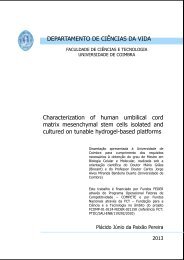role of th1 and th17 cd4+ t cell subsets in the pathogenesis of ...
role of th1 and th17 cd4+ t cell subsets in the pathogenesis of ...
role of th1 and th17 cd4+ t cell subsets in the pathogenesis of ...
You also want an ePaper? Increase the reach of your titles
YUMPU automatically turns print PDFs into web optimized ePapers that Google loves.
<strong>in</strong>flammation show <strong>in</strong>creased levels <strong>of</strong> CCR5, as well as <strong>of</strong> CCL3, CCL4 <strong>and</strong> CCL5<br />
(Balashov et al., 1999). In mice with EAE <strong>the</strong> same is true, but CCL3 <strong>and</strong> CCR5 deficient<br />
mice are not resistant to EAE immunization nor those treated with <strong>the</strong> antagonist met‐<br />
RANTES (Glab<strong>in</strong>ski et al., 1998;Tran et al., 2000a;Matsui et al., 2002).<br />
40<br />
1.5.2 CCR6 AND ITS LIGANDS<br />
CCR6, preferentially expressed by most B <strong>cell</strong>s, immature DCS <strong>and</strong> effector memory T<br />
<strong>cell</strong>s, was recently described to be expressed also <strong>in</strong> Th17 <strong>cell</strong>s <strong>and</strong> regulatory T <strong>cell</strong>s.<br />
CCL20 (MIP3‐α) but also, with lower aff<strong>in</strong>ity, <strong>the</strong> β‐defens<strong>in</strong> group <strong>of</strong> antimicrobial<br />
peptides b<strong>in</strong>d CCR6. Th17 <strong>cell</strong>s are also able to express CCL20, mak<strong>in</strong>g <strong>the</strong>m also<br />
potential recruiters <strong>of</strong> both Th17 <strong>and</strong> Tregs. Absence <strong>of</strong> CCR6 <strong>in</strong> Th17 <strong>cell</strong>s was found to<br />
slightly delay EAE onset, as <strong>in</strong> <strong>the</strong> case <strong>of</strong> CCR6 knock‐out mice (Yamazaki et al., 2008).<br />
CCR6 <strong>and</strong> CCL20 are up‐regulated <strong>in</strong> dra<strong>in</strong><strong>in</strong>g lymph nodes <strong>and</strong> sp<strong>in</strong>al cord dur<strong>in</strong>g EAE,<br />
<strong>and</strong> <strong>the</strong> disease can be attenuated with a neutraliz<strong>in</strong>g antibody or antagonist for CCR6<br />
(Liston et al., 2009). CCL20 is expressed ei<strong>the</strong>r constitutively or follow<strong>in</strong>g <strong>in</strong>duction <strong>in</strong> a<br />
variety <strong>of</strong> epi<strong>the</strong>lial <strong>cell</strong> types, <strong>in</strong>clud<strong>in</strong>g kerat<strong>in</strong>ocytes, pulmonary <strong>and</strong> <strong>in</strong>test<strong>in</strong>al<br />
epi<strong>the</strong>lial <strong>cell</strong>s <strong>and</strong> is highly <strong>in</strong>duced follow<strong>in</strong>g <strong>in</strong>flammatory stimuli. CCR6 seems to play<br />
a <strong>role</strong> <strong>in</strong> Th17 <strong>cell</strong>s migration to certa<strong>in</strong> <strong>in</strong>test<strong>in</strong>e microenvironments express<strong>in</strong>g CCL20<br />
where <strong>the</strong>se receptors can regulate <strong>the</strong> balance between effector <strong>and</strong> regulatory T <strong>cell</strong>s<br />
<strong>in</strong> <strong>the</strong> gut (Wang et al., 2009).<br />
1.5.3 CCR8 AND ITS LIGANDS<br />
CCR8 has been detected <strong>in</strong> Th2 <strong>cell</strong>s, regulatory T <strong>cell</strong>s, macrophages <strong>and</strong> microglia.<br />
CCR8 has only one lig<strong>and</strong>, CCL1 (I‐309). In MS lesions, phagocytic macrophages <strong>and</strong><br />
activated microglia were found positive for CCR8 <strong>and</strong> correlated with active<br />
demyel<strong>in</strong>ation (Trebst et al., 2003). CCR8 is also up‐regulated <strong>in</strong> EAE bra<strong>in</strong> <strong>and</strong> sp<strong>in</strong>al<br />
cord, as well as CCL1 <strong>in</strong> sp<strong>in</strong>al cord before EAE onset (Godiska et al., 1995). CCR8‐CCL1<br />
<strong>in</strong>teraction seems to be essential for <strong>the</strong> <strong>pathogenesis</strong> as CCR8 deficient mice develop<br />
later onset <strong>and</strong> milder EAE symptoms (Murphy et al., 2002)

















